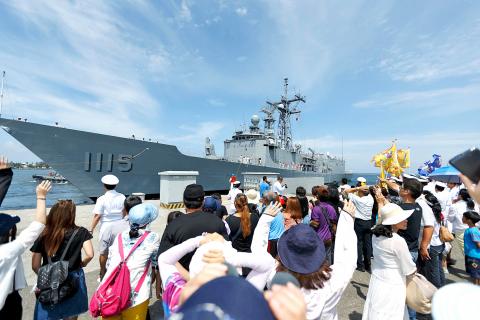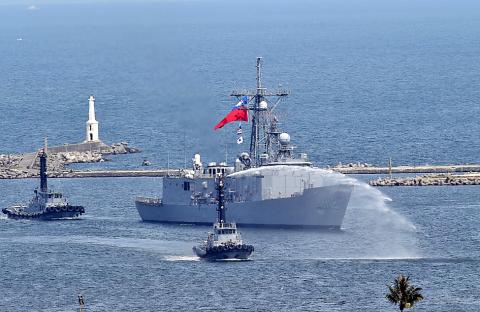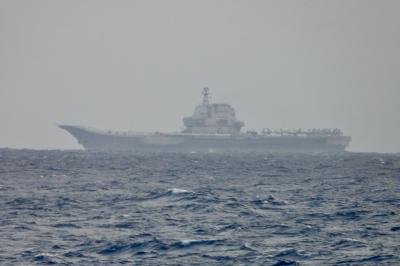Two Perry-class guided-missile frigates purchased from the US arrived in Kaohsiung yesterday, an acquisition that the Republic of China (ROC) Navy said will increase its anti-submarine capability.
Flying ROC national flags, the vessels, crewed by Taiwanese, sailed into Zuoying Military Harbor in Kaohsiung at about 9:30am, where a welcoming ceremony was held by the military.
A commissioning ceremony is slated for July next year, according to military sources.

Photo: CNA
The ships — which were cheaper than Taiwanese-made Cheng Kung-class frigates, the design of which is based on Perry-class frigates — were built in the 1980s.
The navy renamed them Ming Chuan No. 1112 and Feng Chia No. 1115.
They are to join the navy’s 146th fleet based on the outlying island of Penghu, from where they are to patrol the Taiwan Strait, the sources said.

Photo: Chang Chung-yi, Taipei Times
Perry-class frigates have high mobility and are equipped with the SQQ-89 undersea warfare combat system and the SQR-19 sonar system, both of which the military said would beef up its anti-submarine capabilities.
Then-US president Barack Obama signed a bill into law in December 2014 that authorized the sale of four Perry-class frigates to Taiwan.
Taipei budgeted about NT$5.5 billion (US$182 million at today’s exchange rate) in 2014 to purchase two of the ships, which were formerly named the USS Taylor (EFG-50) and the USS Gary (EFG-51) of the US Navy.
Admiral Huang Shu-kuang (黃曙光), commander of the ROC Navy, and family members of the crew were at the port to welcome the ships as they docked.
An official who declined to be named said the navy had been working with its US counterpart since May last year to bring the ships to Taiwan, adding that the crew underwent 10 months of tests and training with the US military.
The frigates are to be fitted with new equipment, while officers will be trained with the new ships before they are added into the naval force, the official said.
“Maintaining security and unimpeded passage in the waters around Taiwan is the navy’s greatest responsibility. We hope we will continue to have support in making arms purchases to ensure we can undertake this responsibility,” the sources said.
The numbering of the frigates — 1112 and 1115 — follows a convention in which the last two numbers of a ship’s name cannot add up to four, nor can the last digit be a four, the official said.
Case of all the digits adding up to four are also not used.
Four in Chinese has a similar pronunciation to the Chinese word for “die” (si, 死).
“The idea is that we hope officers will not be distracted by what might be perceived as an ominous ship name,” the official said, adding that as the previous Cheng Kung-class vessel to be added to the fleet was No. 1110, and 1111 adds up to four, the new ships were numbered starting from 1112.

AIR SUPPORT: The Ministry of National Defense thanked the US for the delivery, adding that it was an indicator of the White House’s commitment to the Taiwan Relations Act Deputy Minister of National Defense Po Horng-huei (柏鴻輝) and Representative to the US Alexander Yui on Friday attended a delivery ceremony for the first of Taiwan’s long-awaited 66 F-16C/D Block 70 jets at a Lockheed Martin Corp factory in Greenville, South Carolina. “We are so proud to be the global home of the F-16 and to support Taiwan’s air defense capabilities,” US Representative William Timmons wrote on X, alongside a photograph of Taiwanese and US officials at the event. The F-16C/D Block 70 jets Taiwan ordered have the same capabilities as aircraft that had been upgraded to F-16Vs. The batch of Lockheed Martin

GRIDLOCK: The National Fire Agency’s Special Search and Rescue team is on standby to travel to the countries to help out with the rescue effort A powerful earthquake rocked Myanmar and neighboring Thailand yesterday, killing at least three people in Bangkok and burying dozens when a high-rise building under construction collapsed. Footage shared on social media from Myanmar’s second-largest city showed widespread destruction, raising fears that many were trapped under the rubble or killed. The magnitude 7.7 earthquake, with an epicenter near Mandalay in Myanmar, struck at midday and was followed by a strong magnitude 6.4 aftershock. The extent of death, injury and destruction — especially in Myanmar, which is embroiled in a civil war and where information is tightly controlled at the best of times —

China's military today said it began joint army, navy and rocket force exercises around Taiwan to "serve as a stern warning and powerful deterrent against Taiwanese independence," calling President William Lai (賴清德) a "parasite." The exercises come after Lai called Beijing a "foreign hostile force" last month. More than 10 Chinese military ships approached close to Taiwan's 24 nautical mile (44.4km) contiguous zone this morning and Taiwan sent its own warships to respond, two senior Taiwanese officials said. Taiwan has not yet detected any live fire by the Chinese military so far, one of the officials said. The drills took place after US Secretary

THUGGISH BEHAVIOR: Encouraging people to report independence supporters is another intimidation tactic that threatens cross-strait peace, the state department said China setting up an online system for reporting “Taiwanese independence” advocates is an “irresponsible and reprehensible” act, a US government spokesperson said on Friday. “China’s call for private individuals to report on alleged ‘persecution or suppression’ by supposed ‘Taiwan independence henchmen and accomplices’ is irresponsible and reprehensible,” an unnamed US Department of State spokesperson told the Central News Agency in an e-mail. The move is part of Beijing’s “intimidation campaign” against Taiwan and its supporters, and is “threatening free speech around the world, destabilizing the Indo-Pacific region, and deliberately eroding the cross-strait status quo,” the spokesperson said. The Chinese Communist Party’s “threats